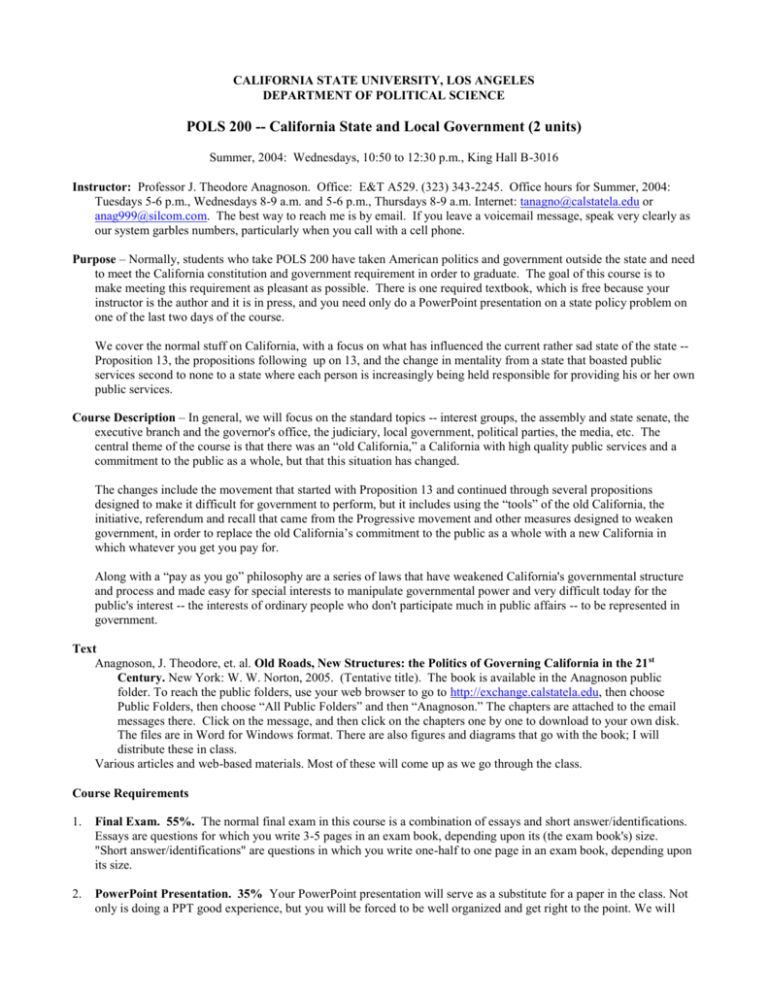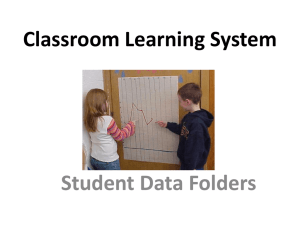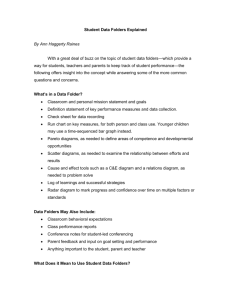Chapter 2: The Constitution and the Progressive Legacy
advertisement

CALIFORNIA STATE UNIVERSITY, LOS ANGELES DEPARTMENT OF POLITICAL SCIENCE POLS 200 -- California State and Local Government (2 units) Summer, 2004: Wednesdays, 10:50 to 12:30 p.m., King Hall B-3016 Instructor: Professor J. Theodore Anagnoson. Office: E&T A529. (323) 343-2245. Office hours for Summer, 2004: Tuesdays 5-6 p.m., Wednesdays 8-9 a.m. and 5-6 p.m., Thursdays 8-9 a.m. Internet: tanagno@calstatela.edu or anag999@silcom.com. The best way to reach me is by email. If you leave a voicemail message, speak very clearly as our system garbles numbers, particularly when you call with a cell phone. Purpose – Normally, students who take POLS 200 have taken American politics and government outside the state and need to meet the California constitution and government requirement in order to graduate. The goal of this course is to make meeting this requirement as pleasant as possible. There is one required textbook, which is free because your instructor is the author and it is in press, and you need only do a PowerPoint presentation on a state policy problem on one of the last two days of the course. We cover the normal stuff on California, with a focus on what has influenced the current rather sad state of the state -Proposition 13, the propositions following up on 13, and the change in mentality from a state that boasted public services second to none to a state where each person is increasingly being held responsible for providing his or her own public services. Course Description – In general, we will focus on the standard topics -- interest groups, the assembly and state senate, the executive branch and the governor's office, the judiciary, local government, political parties, the media, etc. The central theme of the course is that there was an “old California,” a California with high quality public services and a commitment to the public as a whole, but that this situation has changed. The changes include the movement that started with Proposition 13 and continued through several propositions designed to make it difficult for government to perform, but it includes using the “tools” of the old California, the initiative, referendum and recall that came from the Progressive movement and other measures designed to weaken government, in order to replace the old California’s commitment to the public as a whole with a new California in which whatever you get you pay for. Along with a “pay as you go” philosophy are a series of laws that have weakened California's governmental structure and process and made easy for special interests to manipulate governmental power and very difficult today for the public's interest -- the interests of ordinary people who don't participate much in public affairs -- to be represented in government. Text Anagnoson, J. Theodore, et. al. Old Roads, New Structures: the Politics of Governing California in the 21 st Century. New York: W. W. Norton, 2005. (Tentative title). The book is available in the Anagnoson public folder. To reach the public folders, use your web browser to go to http://exchange.calstatela.edu, then choose Public Folders, then choose “All Public Folders” and then “Anagnoson.” The chapters are attached to the email messages there. Click on the message, and then click on the chapters one by one to download to your own disk. The files are in Word for Windows format. There are also figures and diagrams that go with the book; I will distribute these in class. Various articles and web-based materials. Most of these will come up as we go through the class. Course Requirements 1. Final Exam. 55%. The normal final exam in this course is a combination of essays and short answer/identifications. Essays are questions for which you write 3-5 pages in an exam book, depending upon its (the exam book's) size. "Short answer/identifications" are questions in which you write one-half to one page in an exam book, depending upon its size. 2. PowerPoint Presentation. 35% Your PowerPoint presentation will serve as a substitute for a paper in the class. Not only is doing a PPT good experience, but you will be forced to be well organized and get right to the point. We will cover some PPT fundamentals in class. Topics: any policy problem would be OK, things like redistricting in California, term limits, Indian gambling, workers’ compensation, the influence of money in the Assembly and Senate elections, the influence of the Progressives on current California governmental structure and policies, Proposition 13, Proposition 98 and its effects on K-12 and community college education, the Master Plan for higher education in California and its effects….there are lots. You do the equivalent research to a term paper, but you format only the PPT and notes on it. You present the presentation in class. 3. Class participation. 10% It counts. Don't be silent. Class participation is an important part of the learning process in the course. Participation is not just what discussion leaders do; it is the responsibility of all of us to make worthwhile contributions to the class discussion, including asking questions. A good question is often the key to obtaining good answers. Quality and quantity are both judged in assessing your classroom participation. 4. Policy on attendance. Attendance is not required. However, you should attend every class, and if you don’t, it will count against you gradewise. For most students, there is a high correlation between attendance and the amount learned and thus the grade. Very few students can attend only sporadically and do well on exams and papers. 5. Questionnaires on Each Sample Chapter. There will be short questionnaires asking for feedback on each chapter, as we go through the book. You should be honest on these; honest criticism is genuinely helpful to us at this stage. Other things to know: Paper policy (fyi) – Papers must be typed. Policy on stylistic and grammatical errors is the same policy as is used in manufacturing automobiles – the goal is zero defects (no spelling errors, no grammatical errors, etc.). Use a spell check program, an editor…whatever works. Academic Dishonesty / Cheating policy -- You need to do your own work. Collaborating with others either in the class or outside it is ENCOURAGED for class discussion and in preparing your book reviews. But when you sit down to write your book review, you need to observe all the standard rules of attribution -- if you get an idea or a phrase or a quote or a paraphrase or anything at all from another source, it needs to be acknowledged, even if that is an idea you got from a friend or someone else in the class. Use the MLA style with the author's name and the page number at the end of the sentence (Anagnoson, 96). You can use the formal footnote style, but I have found it is much more work than the MLA style. If I find that you have copied material from another source without attribution, I will give you a zero for the particular piece of work in question (your term paper) and report you to the Coordinator of Student Discipline for disciplinary action. Communicating with the instructor: email is the most efficient. Our voicemail system garbles people's voices, so if you leave a message, be sure to speak clearly. Grading Policy – plus and minus grades are used in this class. Cell Phones and Pagers -- please turn these off in class. Lecture/Discussion Schedule 1. 2. Introduction. Chapter 1: What California Government Does and Why It Matters Chapter 2: The Constitution and the Progressive Legacy 3. Chapter 3: California Politics and Interest groups 4. Chapter 4: Political Parties and the Media 5. Chapter 5: Campaigns, Voting, Elections 6. Chapter 6: The California Legislature 7. Chapter 7: The Governor and the Executive Branch 8. Chapter 8: The California Judiciary 9. Chapter 9: The State Budget and Budgetary Limitations 10. Chapter 10: Local Government 11. Chapter 11: Public Policy in California 2








